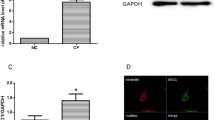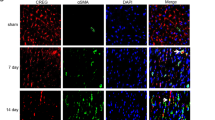Abstract
Increasing evidence suggests that PCSK9 inhibition protects cardiomyocytes against ischemia-reperfusion injury after myocardial infarction. However, it is not clear whether PCSK9 inhibitor (PCSK9i) affects cardiac fibroblasts (CFs) activation after MI. In this study we used SBC-115076, an antagonist of PCSK9, to investigate the role of PCSK9i in the conversion of CFs to cardiac myofibroblasts (CMFs) after MI and provided a basic for its clinical application in cardiac fibrosis after MI. In vivo study, PCSK9i was injected into mice 4 days after MI. Cardiac function and degree of fibrosis were evaluated by echocardiographic and tissue staining after treatment. Western blot showed that PCSK9i treatment decreases expression of α-SMA, collagen and increases expression of Notch1 in border infarct area. Vitro studies showed that PCSK9i decreased the degree of fibrosis, migration, and collagen fiber deposition in CFs. Confocal microscopy imaging also showed that hypoxia contributes to the formation of α-SMA stress filaments, and PCSK9i alleviated this state. Moreover, overexpression of Notch1 further suppress the activation of CFs under hypoxia. These results revealed that SBC-115076 ameliorates cardiac fibrosis and ventricular dysfunction post-myocardial infarction through inhibition of the differentiation of cardiac fibroblasts to myofibroblasts via Notch1/Hes1 signaling.






Similar content being viewed by others
References
Talman, V., & Ruskoaho, H. (2016). Cardiac fibrosis in myocardial infarction-from repair and remodeling to regeneration. Cell and Tissue Research, 365, 563–581.
Frangogiannis, N. G. (2019). Cardiac fibrosis: cell biological mechanisms, molecular pathways and therapeutic opportunities. Molecular Aspects of Medicine, 65, 70–99.
Tallquist, M. D. (2020). Cardiac fibroblast diversity. Annual Review of Physiology, 82, 63–78.
Pei, H., Du, J., Song, X., He, L., Zhang, Y., Li, X., Qiu, C., Zhang, Y., Hou, J., Feng, J., Gao, E., Li, D. & Yang, Y. (2016). Melatonin prevents adverse myocardial infarction remodeling via Notch1/Mfn2 pathway. Free Radical Biology and Medicine, 97, 408–417.
Yu, L., Li, F., Zhao, G., Yang, Y., Jin, Z., Zhai, M., Yu, W., Zhao, L., Chen, W., Duan, W., & Yu, S. (2015). Protective effect of berberine against myocardial ischemia reperfusion injury: role of Notch1/Hes1-PTEN/Akt signaling. Apoptosis. 20, 796–810.
Bi, P. & Kuang, S. (2015). Notch signaling as a novel regulator of metabolism. Trends in Endocrinology and Metabolism, 26, 248–255.
Hu, B. & Phan, S. H. (2016). Notch in fibrosis and as a target of anti-fibrotic therapy. Pharmacological Research, 108, 57–64.
Sabatine, M. S., Giugliano, R. P., Keech, A. C., Honarpour, N., Wiviott, S. D., Murphy, S. A., Kuder, J. F., Wang, H., Liu, T., Wasserman, S. M., Sever, P. S. & Pedersen, T. R. (2017). Evolocumab and clinical outcomes in patients with cardiovascular disease. New England Journal of Medicine, 376, 1713–1722.
Abifadel, M., Varret, M. & Rabès, J. P. et al. (2003). Mutations in PCSK9 cause autosomal dominant hypercholesterolemia. Nature Genetics, 34, 154–156.
Cohen, J. C., Boerwinkle, E., Mosley, T. H. & Hobbs, H. H. (2006). Sequence variations in PCSK9, low LDL, and protection against coronary heart disease. New England Journal of Medicine, 354, 1264–1272.
Ding, Z., Wang, X., Liu, S., Shahanawaz, J., Theus, S., Fan, Y., Deng, X., Zhou, S. & Mehta, J. L. (2018). PCSK9 expression in the ischaemic heart and its relationship to infarct size, cardiac function, and development of autophagy. Cardiovascular Research, 114, 1738–1751.
Cammisotto, V., Pastori, D., Nocella, C., Bartimoccia, S., Castellani, V., Marchese, C., Scavalli, A. S., Ettorre, E., Viceconte, N., Violi, F., Pignatelli, P. & Carnevale, R. (2020). PCSK9 regulates Nox2-mediated platelet activation via CD36 receptor in patients with atrial fibrillation. Antioxidants (Basel), 9, 296.
Qi, Z., Hu, L., & Zhang, J. et al. (2021). PCSK9 (Proprotein Convertase Subtilisin/Kexin 9) enhances platelet activation, thrombosis, and myocardial infarct expansion by binding to platelet CD36. Circulation, 143, 45–61.
Andreadou, I., Tsoumani, M., Vilahur, G., Ikonomidis, I., Badimon, L., Varga, Z. V., Ferdinandy, P. & Schulz, R. (2020). PCSK9 in myocardial infarction and cardioprotection: importance of lipid metabolism and inflammation. Frontiers in Physiology, 11, 602497.
Ding, Z., Wang, X., Liu, S., Shahanawaz, J., Theus, S., Fan, Y., Deng, X., Zhou, S. & Mehta, J. L. (2021). Corrigendum to: PCSK9 expression in the ischaemic heart and its relationship to infarct size, cardiac function, and development of autophagy. Cardiovascular Research, 114, 1738–1751.
Lee, G. E., Kim, J., Lee, J. S., Ko, J., Lee, E. J. & Yoon, J. S. (2020). Role of proprotein convertase subtilisin/kexin type 9 in the pathogenesis of graves’ orbitopathy in orbital fibroblasts. Frontiers in Endocrinology, 11, 607144.
Poirier, S., Prat, A., Marcinkiewicz, E., Paquin, J., Chitramuthu, B. P., Baranowski, D., Cadieux, B., Bennett, H. P. & Seidah, N. G. (2006). Implication of the proprotein convertase NARC-1/PCSK9 in the development of the nervous system. Journal of Neurochemistry, 98, 838–850.
Roudaut, M., Idriss, S. & Caillaud, A. et al. (2021). PCSK9 regulates the NODAL signaling pathway and cellular proliferation in hiPSCs. Stem Cell Reports, 16, 2958–2972.
Wang, P., Zhang, W., Feng, Z., Zhang, J., Sun, Y. & Zhang, W. (2021). LDL‑induced NLRC3 inflammasome activation in cardiac fibroblasts contributes to cardiomyocytic dysfunction. Molecular Medicine Reports, 24, 526.
Amput, P., Palee, S., Arunsak, B., Pratchayasakul, W., Thonusin, C., Kerdphoo, S., Jaiwongkam, T., Chattipakorn, S. C. & Chattipakorn, N. (2020). PCSK9 inhibitor and atorvastatin reduce cardiac impairment in ovariectomized prediabetic rats via improved mitochondrial function and Ca(2+) regulation. Journal of Cellular and Molecular Medicine, 24, 9189–9203.
Kong, P., Christia, P. & Frangogiannis, N. G. (2014). The pathogenesis of cardiac fibrosis. Cellular and Molecular Life Sciences, 71, 549–574.
Norambuena-Soto, I., Núñez-Soto, C., Sanhueza-Olivares, F., Cancino-Arenas, N., Mondaca-Ruff, D., Vivar, R., Díaz-Araya, G., Mellado, R. & Chiong, M. (2017). Transforming growth factor-beta and Forkhead box O transcription factors as cardiac fibroblast regulators. BioScience Trends, 11, 154–162.
Ahn, J. S., Ann, E. J., Kim, M. Y., Yoon, J. H., Lee, H. J., Jo, E. H., Lee, K., Lee, J. S., & Park, H. S. (2016). Autophagy negatively regulates tumor cell proliferation through phosphorylation dependent degradation of the Notch1 intracellular domain. Oncotarget, 7, 79047–79063.
Sarin, A., & Marcel, N. (2017). The NOTCH1-autophagy interaction: regulating self-eating for survival. Autophagy, 13, 446–447.
Hu, M., Ou-Yang, H. F., Wu, C. G., Qu, S. Y., Xu, X. T. & Wang, P. (2014). Notch signaling regulates col1α1 and col1α2 expression in airway fibroblasts. Experimental Biology and Medicine, 239, 1589–1596.
Acknowledgements
The authors wish to thank all the investigators and supporters involved in this study.
Funding
This research was granted through the National Natural Science Foundation of China (grant no. 81974022) and Shanghai Municipal Health Commission (grant no. 201940206).
Author information
Authors and Affiliations
Contributions
C.W.: writing - original draft; writing - review & editing, D.-w.L.: writing - original draft, writing - review & editing, J.J.: writing - original draft; data curation and analysis, Y.-w.J.: writing - original draft; data curation, F.J.: data analysis; project administration, Y.-s.W.: writing - review & editing, supervision, funding acquisition.
Corresponding author
Ethics declarations
Conflict of interest
The authors declare no competing interests.
Additional information
Publisher’s note Springer Nature remains neutral with regard to jurisdictional claims in published maps and institutional affiliations.
Rights and permissions
Springer Nature or its licensor (e.g. a society or other partner) holds exclusive rights to this article under a publishing agreement with the author(s) or other rightsholder(s); author self-archiving of the accepted manuscript version of this article is solely governed by the terms of such publishing agreement and applicable law.
About this article
Cite this article
Wu, C., Lin, D., Ji, J. et al. PCSK9 Inhibition Regulates Infarction-Induced Cardiac Myofibroblast Transdifferentiation via Notch1 Signaling. Cell Biochem Biophys 81, 359–369 (2023). https://doi.org/10.1007/s12013-023-01136-1
Received:
Accepted:
Published:
Issue Date:
DOI: https://doi.org/10.1007/s12013-023-01136-1




